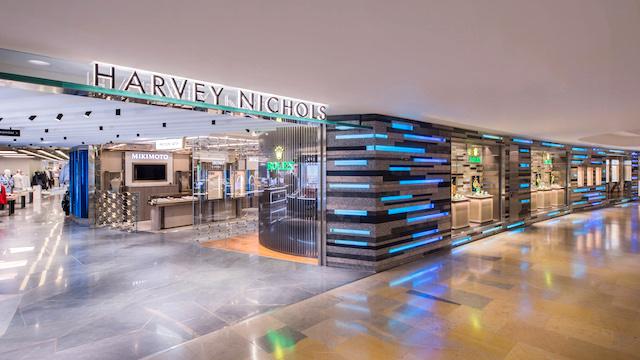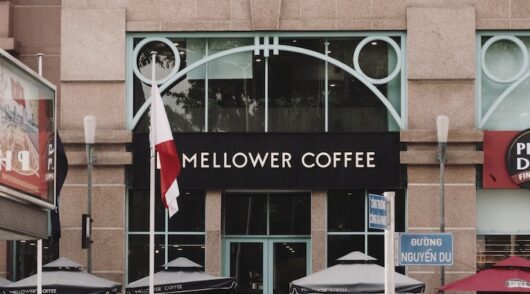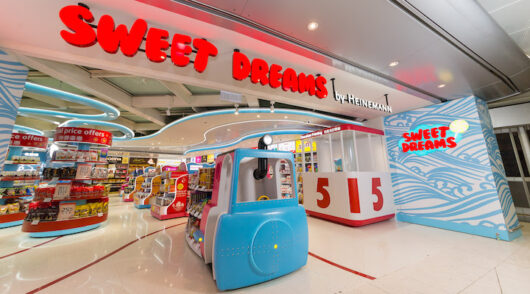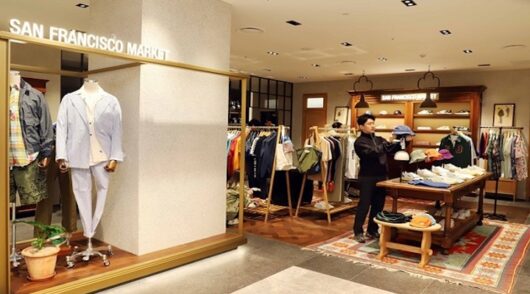Harvey Nichols in Hong Kong has unveiled a retail concept it believes will win favour from online shoppers and enhance the customer experience of those who want to shop in a brick-and-mortar store.
With flagship stores from international brands and pure-play online retailers making life tough for department stores all over the world, Harvey Nichols, with stores in the UK, Middle East, Turkey and Hong Kong, has not been immune to the trend.
“We see the retail landscape changing alot in the sense that online you have very strong competition from the pure-play retailers who were obviously extremely aggressive, and a lot of them very successful now and engaging customers, especially younger ones,” explains Pearson Poon, son of Dickson Concepts founder Sir Dickson Poon, and executive director of Harvey Nichols.
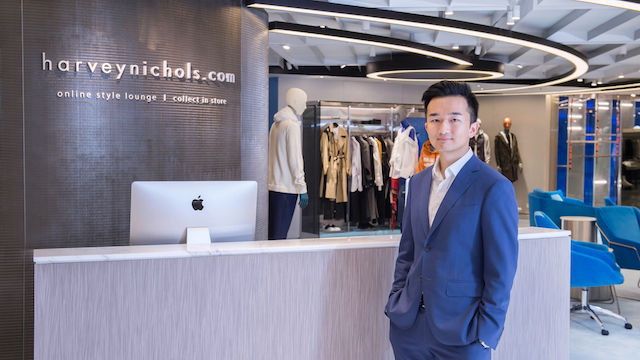
“We really believe customers will not shop only online, and that the [physical] store is still very important.”
But he accepts that stores have to change a lot to meet the challenge. “In the past, maybe a lot of department stores could rely on a few brands, stock only those and the customers would come because of that. But in today’s world, that strategy is quite difficult. A lot of the major designer brands have very big flagship stores now. So, if you’re a customer looking for a specific brand, probably the best place to go is a huge flagship store where you can have the biggest offering from that particular brand, and have someone knowledgeable about the brand serving you.
“So, we really felt that we needed to have a store that customers would come to not just because they’re looking for a particular brand, but because they really enjoy the experience of coming. And because of the product offer.”
That summarises the philosophy behind the new Pacific Place concept store for Harvey Nichols in Hong Kong, designed by Studio Four IV and created “to optimise the synergies between our online and offline platforms,” explains Poon.
Most department stores nowadays have both an online platform and physical stores. Normally the product range across both are identical or at least extremely similar. But the overlap between the new Harvey Nichols store’s stock and the retailer’s online range is just 10 per cent.
“As a result of all this, we’re essentially able to reduce our physical space by half, to 40,000sqft, but at the same time, triple the number of products we can show to our customers,” explains Poon. “We really focused the store on discovery and exploration.
“We think this is a much more interesting and fun way to shop. And we think it’s the first of its kind, certainly in Hong Kong and probably elsewhere in the world in terms of how we’re showing the online products and the offline products within one space and really making that the heart of the store.
“Online, we focus on our international offering and inside the stores, we focus on a lot of new emerging brands and local offerings.” Those include upcoming Japanese and South Korea brands yet to establish the sort of top-of-mind brand recall which would enable them to sell in high volumes online.
Interactive screens
So how do you lure visitors into a physical store to peruse a vast online catalogue in an engaging and relaxed manner?
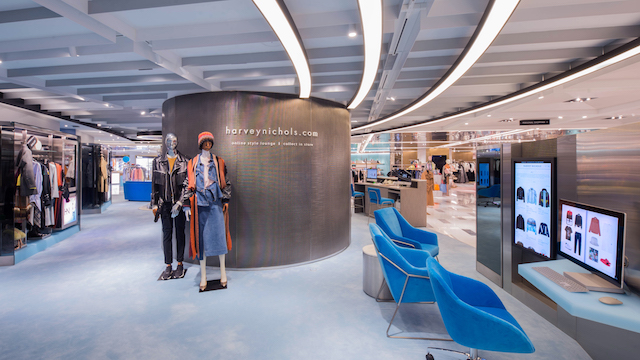
Digital screens are key at the new Harvey Nichols in Hong Kong store at Pacific Place. It begins outside where an interactive screen is built into the shop window allowing customers to browse products online.
“You can click on any product that you see on the touch screen and then a model wearing that product will show on screen right away. So even before the customer enters the store we really hope to engage them.”
It is what Poon describes as “cross category”. Shoppers can assemble a complete outfit if they wish, including top, skirt, shoes and handbags and see them all together.
That screen solution is replicated in store where one of the five or six stylists on duty can also recommend items that might match or suit the shopper, adding a more personal touch to the experience.
Throughout the store, some racks have been replaced with screens, most of them around 50” because that size gives the closest simulation to the real size of the apparel. Using their phone, a customer can scan a product’s QR code from the screen and immediately see different angles of the item, along with details like the fabric composition, size and fit.
Engagement drives conversion Poon says that in luxury goods, conversion rates are higher offline than online not only because shoppers can touch and feel the product in a store, but also because of a lack of service online.
So the company is replicating the level of engagement in stores online. Several years ago in the UK, Harvey Nichols introduced a button on its website where shoppers could click to connect with a stylist from the Harvey Nichols store closest to them.
“From that you can connect to the stylist directly, either via instant messaging, photo sharing, or even live-video streaming,” explains Poon. “So whether it’s face to face conversation or by text, you can communicate with the stylists and get the advice or recommendations that you need.
“Since we launched that in the UK, we’ve seen that on average, when our customers first engage with one of our stylists they’re five times more likely to buy something, and they spend twice as much as they normally would.
“And that doesn’t surprise me in the sense that a lot of the times when you have something that may be sold out in your size, customers may just think ‘okay, I’ll leave it’. But [at Harvey Nichols online] you can have someone help you by saying, ‘Oh, I know your size may be out of stock now, but I would recommend these other products that I think suits you even more or is similar. Whenever you have someone serving you … it gives you much more confidence. For a lot of our brands, when you look at it online, you may think, ‘oh, I don’t understand why that particular blazer may cost £1000 or £2000’. But when you have one of our stylists explaining the construction or the brand, it gives you much more understanding as to why that might cost so much.”
With many Hongkongers working long hours during the day, it may not be convenient to visit a physical store, hence some shoppers head online instead.
During the day, Hong Kong stylists will connect with customers online – but after 9pm, stylists based in the UK take over, ensuring service for as much of a 24-hour day as possible.
“Through this, we’re really hoping to close the gap between online and offline in terms of service. And hopefully this would create a differentiation between our online platform versus all the other platforms out there and really give our customers that consistent experience that they would expect whether they’re shopping in the store or online,” says Poon.
From early days – before the new store opened – Poon says a large proportion of customers were buying online and opting to collect in a store.
“This is actually driving a lot of traffic to stores. There are a lot of synergies between the two channels. Sometimes when [customers] come in, they realise there are a lot of new interesting brands they haven’t seen before.
And as a result, they become our store customers. And then … we will also have customers who only shop at the store suddenly learning about the online offer, and as a result also become online customers.
“Once you drive a customer into the store, you have the chance to convert them and hopefully attract a lot of first-time visitors as well. I think that’s why, especially now, a lot of retailers are struggling to generate good, consistent traffic to their stores. It’s important to think about how you can leverage the online platforms to create traffic.”
Designer focus
Besides stocking traditional customer favourite brands such as Valentino and Bally, Harvey Nichols is using its physical stores to introduce new and emerging designers, many of them from Asia. Like menswear label Wooyoungmi, which Harvey Nichols was the first to expand across the region and beyond. “That is now one of our most successful menswear brands. When you have products like that, and customers come in and find something they have never seen before, that’s something they really like.”
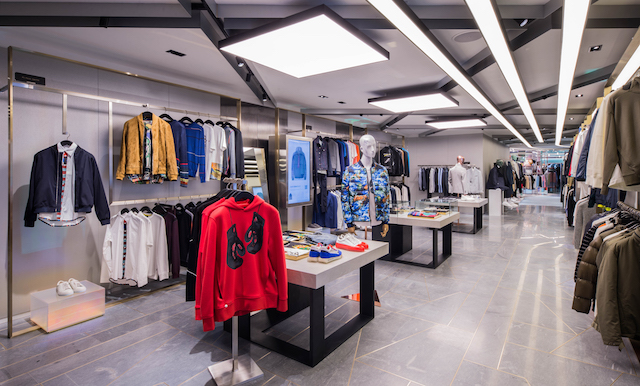
Customers are now shopping Harvey Nichols not because they are looking for a particular brand, but because they know that every time they come in, they can find something new.
Going global
The new Pacific Place format is a trial which, once fine-tuned, will be introduced elsewhere.
“Before jumping into a big expansion spree straight away, we thought we would open this and take some time to gather customer feedback on it. Because we’ve never done something like this before, and we don’t think there are a lot of other retailers we can refer to.
“We don’t have any particular country or geography in mind. But, for instance, we don’t have a store in Mainland China at the moment, or one in Japan. So I think once we have data from how the Pacific Place store is trading we will be in a position to see where else we should go internationally.”
Meanwhile, while most of Harvey Nichols’ online business is currently coming from the UK, the company ships globally and solid growth is showing in purchases from Greater China and the US.
“That gives us the confidence to continue to pursue growth for online. And I think what’s interesting about this is that, especially in new markets, where we may be lesser known for playing such a store would also create so much awareness about our online platform for that particular country.
“I think the physical space is important. And even if you don’t have a physical space, I think the human interaction between a customer and a personal shopper or a stylist is important.”
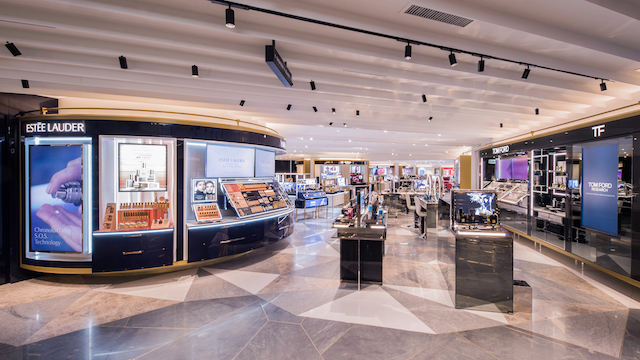
One decision the Harvey Nichols team planning the new concept made early on was that technology installed in the store must have a customer-friendly purpose – not just feature in store because it is new.
“As part of planning the store, we evaluated many, many different pieces of technology and hardware. But ultimately what we have here is really based on what we think can deliver our proposition in the best way. There is a lot of tech out there that is very cold, that doesn’t really enrich the customer experience. And we don’t want to overwhelm the store with screens,” reflects Poon.
“In today’s world of retail, with so many changes, we really need to make the physical store environment a very engaging and fun place to shop.
Otherwise, it’s difficult to retain customers in a physical store environment.
“The whole motivation behind this store is really building a format that we think is suitable for today’s retail world.”
This feature originally appeared in the quarterly Inside Retail Asia magazine. To subscribe to the print or digital versions, check out our shop here.

